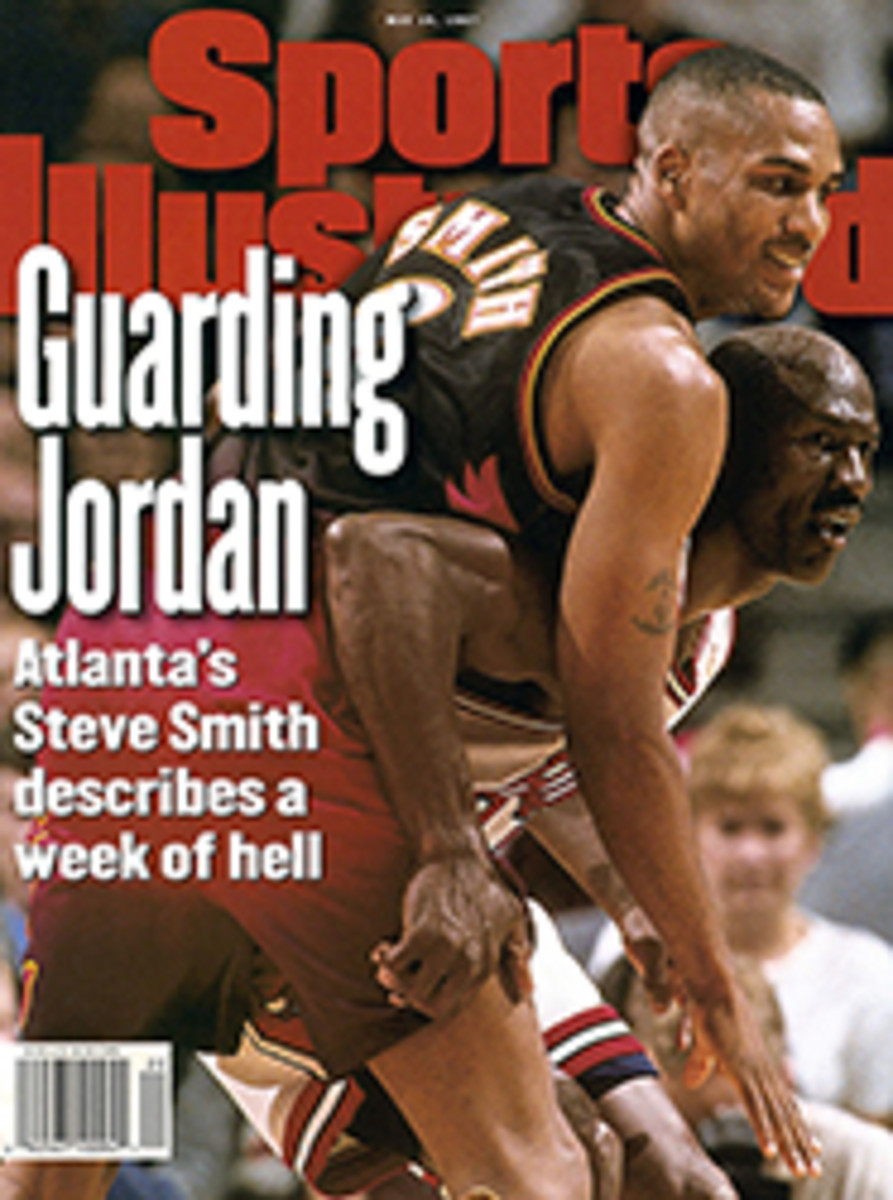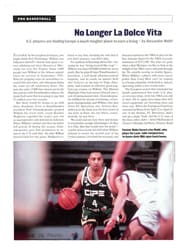
ON THE ROAD AGAIN CYCLIST GREG LEMOND FINDS FAST NEW WHEELS
Cornering into a sharp turn at 50 mph, three-time Tour de France
champion Greg LeMond takes a tight line, and another racer
trying to sneak by on the inside crashes into him. LeMond
suffers no road rash from the collision, but he can't just grab
a spare bike and continue the race. These days LeMond's ride is
a race car, and it isn't so easily replaced. LeMond, 35, who
retired from professional cycling in 1994 because of a rare
cellular disorder that sapped his energy, has a new competitive
focus: the U.S. Formula Ford 2000 racing series.
His new Ford, number 83, is bright yellow, like the leader's
jersey in the Tour de France. But as a rookie FF2000 racer
LeMond hasn't approached the triumphs he celebrated speeding to
victory up the Champs-Elysees in Paris. In the Indy 200 at Walt
Disney World in January, he crashed into a wall at 80 mph in a
qualifying round, then eked out a 20th-place finish in the race
itself. In his second start, the Kash N' Karry Florida Grand
Prix, in St. Petersburg, on Feb. 23, LeMond qualified 18th but
was taken out in Turn 1 of Lap 1 by another racer. In March at
the Phoenix 200, LeMond raced in the middle of the pack before
he was taken out by a spinning car. Last month he finished 21st
in one race and broke down on the last lap of another.
According to Warren Gibson, LeMond's longtime friend and
consultant, the cyclist's switch to race car driver was a
necessary adaptation. "Every year he had goals and a schedule
for what he should do to reach those goals," says Gibson. "When
Greg retired he no longer had that. But now he's got that
commitment."
LeMond found his new commitment a year and a half ago, when, at
the urging of his friend Frank Bennett, he got behind the wheel
at the Russell Racing School in Monterey, Calif. "After a
20-minute session, I was like, Woo hoo!" says LeMond. He
enrolled in the school, took advanced courses and finished third
in Russell's season-ending competition. Then, on a rainy
afternoon last July, LeMond paid $6,000 to lease a race car and
entered a professional race in downtown Minneapolis, not far
from his home in Medina, Minn. He finished a respectable 12th.
"I drove cautiously," he says. "I didn't want to pay damages."
Last fall LeMond found someone else to foot the racing bills,
which run about $150,000 annually for the car, mechanics and
travel in the nine-stop, 12-race FF2000 series. John Miller,
president of Miller Milling Company, a durum wheat mill in
Minneapolis, signed LeMond to his Miller Brothers racing team
because, Miller says, "we felt that he could safely run in this
category, and that it was the logical next step if he's serious
about a career in racing." And, Miller admits, the publicity
LeMond attracts doesn't hurt.
"He's not going to win a race tomorrow or next week, but he's
already climbed an incredibly steep learning curve for someone
with so little experience," says Miller, who has been racing for
more than 10 years. "If he continues, by the end of the season
he'll be a contender to win races."
To maneuver the open-wheeled, two-liter Ford at speeds of up to
150 mph requires great confidence, especially for a rookie
accustomed to sitting high on a bike seat. Low in the driver's
bay, LeMond is bound to his foam-contoured seat by a seat belt,
chest and crotch straps, and forearm restraints. He cannot see
the nose of the car, its jutting tires or how close the tires
come to the concrete safety barriers in turns. He has a mirror
smaller than a bike pedal on either side of the car to see
traffic approaching from behind. "I only have about 33 days of
racing experience," LeMond says. "That's not much. I can't
imagine racing a bike with only 33 days of riding. But in car
racing you don't have the luxury of being able to drive whenever
you want." He is still getting used to turns and traffic. Except
for LeMond, all of this year's FF2000 rookies have several years
of amateur racing or go-karting experience.
"I don't think Greg's ever even changed the oil in a car," says
his wife, Kathy. She took a three-day racing course to have a
better understanding of what her husband experiences on the
track. "He's been reading lots of racing books," she says. "We
were trying to remember back to my college physics to figure out
some of the aerodynamics."
Greg's most valuable asset in overcoming his mechanical
ignorance is his driving coach, Steve Knapp, last year's FF2000
champion. "The system we've worked out is, on test days, I'll
run the car for a few laps with the same setup he uses," says
Knapp, who is the lead driver for Miller Racing. "Then we look
at the computer data and show him where I'm faster and go from
there." The data come from a racing software program, used by
most professional teams, that records driver and car performance
on a card in the car's computer. After a run, the card is
transferred into a laptop, and Knapp analyzes the information to
recommend adjustments for LeMond to make. "Listening to Greg's
stories at night over dinner, you can tell that cycling and car
racing are real similar sports," says Knapp. "It's just that now
everything comes at him a lot faster."
Knapp believes his charge will advance to a higher level of
racing--the KOOL/Toyota Atlantic series, for example, in which
Knapp now drives--and might even get up to Indy or Formula One.
But LeMond knows that he's not much closer to the Indy 500 than
he was to the Tour de France when, at 14, he got his first
racing bicycle and began riding the country roads of the Washoe
Valley of Nevada. "Who knows? I might find out I don't have what
it takes," he says. "I don't think I'd stick with car racing if
I weren't improving. I think when you start to plateau, you have
to reanalyze."
Then again, LeMond seems a good bet to succeed. No American had
won the Tour de France before LeMond won the race in 1986. But
in 1987 he nearly bled to death after his brother-in-law
accidentally shot him in the back while they were hunting wild
turkeys. In LeMond's torso there are still about 40 lead shotgun
pellets that doctors decided to leave there rather than risk
causing further damage by removing them. LeMond went through a
grueling, yearlong rehabilitation program that led eventually to
a stirring come-from-behind victory at the 1989 Tour de France.
But in 1991 he began to experience severe fatigue, and his
performance soon started to fall off. In 1994, as part of a
battery of tests, he underwent a muscle biopsy. LeMond pulls up
his shorts to reveal the wormlike scar on his thigh where
doctors sliced off six strips of muscle--"like sashimi," he
likes to say. The diagnosis was mitochondria myopathy, a rare
disorder in which the mitochondria in his cells are inhibited
from converting fat calories to energy at the rate needed by a
world-class athlete.
"If I was sitting behind a desk all day, I'd never know I have
it," says LeMond, whose two sisters are now being tested for the
disorder. "I could probably compete locally in bike races and
still win, but after you've raced at the Tour de France level,
it's like a guy who's raced Indy cars going back to racing in
this series or in go-karts."
LeMond has taken the step back to the bush leagues, albeit in
another sport. There is something odd about seeing the U.S.'s
greatest cyclist in an entry-level racing series filled with
aspiring unknowns and wealthy businessmen looking for a hobby.
Former Indy 500 champ Bobby Rahal stopped by the Miller Brothers
paddock at the Florida Grand Prix, where he was advising a team
in another series, to tell LeMond that he has been a fan of his
for years.
Others flocked to the rookie and presented an odd array of
paraphernalia for him to autograph: cycling jerseys, baseball
caps embroidered with an emblem of his number 83 Ford, Tour de
France posters and Grand Prix programs. They didn't seem to mind
that LeMond crashed early, and they eagerly asked what happened.
"That guy T-boned me," LeMond said. "I wish this was like bike
racing, where you have spares. I wanted to get back out there
and race." Though he's now a middle-of-the pack rookie, LeMond's
spirit has not changed. He has cut down on the road rash, but
he's still looking to become a champion in yellow.
TWO COLOR PHOTOS: ROBERT ROGERS (2) LeMond crashed on the first lap of a race at a Florida track in February, and admits he has plenty to learn. [Greg LeMond driving race car; Greg LeMond]
COLOR PHOTO: AFP LeMond's Tour de France win in 1989 was his second.[Greg LeMond riding bicycle in Tour de France]

